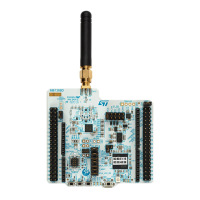Inter-processor communication controller (IPCC) RM0453
386/1450 RM0453 Rev 5
9 Inter-processor communication controller (IPCC)
9.1 IPCC introduction
The inter-processor communication controller (IPCC) is used for communicating data
between two processors.
The IPCC block provides a nonblocking signaling mechanism to post and retrieve
communication data in an atomic way. It provides the signaling for twelve channels:
• six channels in the direction from processor 1 to processor 2
• six channels in the opposite direction
It is then possible to have two different communication types in each direction.
The IPCC communication data must be located in a common memory, which is not part of
the IPCC block.
9.2 IPCC main features
• Status signaling for the twelve channels
– Channel occupied/free flag, also used as lock
• Two interrupt lines per processor
– One for RX channel occupied (communication data posted by sending processor)
– One for TX channel free (communication data retrieved by receiving processor)
• Interrupt masking per channel
– Channel occupied mask
– Channel free mask
• Two channel operation modes
– Simplex (each channel has its own communication data memory location)
– Half duplex (a single channel associated to a bidirectional communication data
information memory location)
9.3 IPCC functional description
The IPCC communication data is located in a common memory, which is not part of the
IPCC block. The address location of the communication data must be known or located in a
known common area that, as already stated, is not part of the IPCC block.
For each communication, the IPCC block provides a channel status flag CHnF.
• When 0, the channel status flag CHnF indicates that the associated IPCC channel is
free (the receiving processor has retrieved communication data), and can be accessed
by the sending processor.
• When 1, the channel status flag CHnF indicates that the associated IPCC channel is
occupied (the sending processor has posted communication data) and can be
accessed by the receiving processor.

